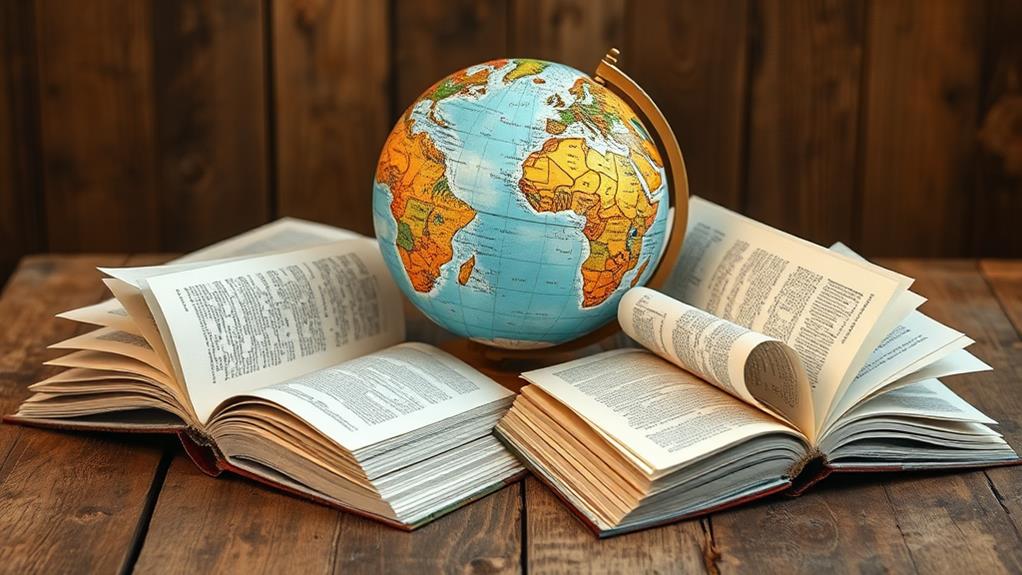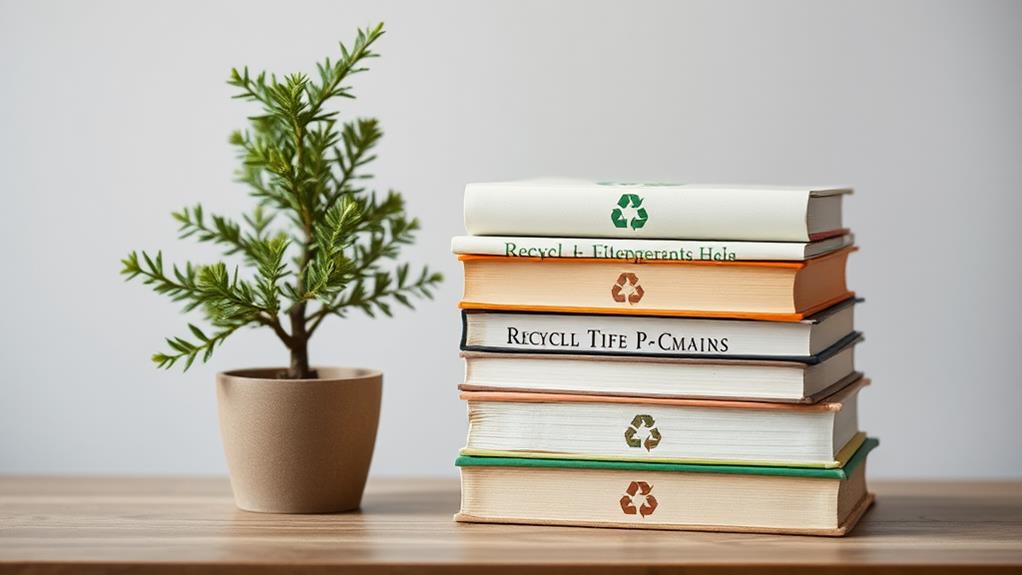Interesting Facts About Books You Never Knew
Books harbor fascinating secrets you might not know. Did you realize some were bound in human skin? Harvard Library owns four such law books. You'll find the world's smallest book measures a mere 100 micrometres, while the largest weighs 1.5 tons. Famous figures like Theodore Roosevelt read a book daily. Regular reading can reduce your Alzheimer's risk and lower stress by 68%. Unwanted books find new life as construction materials or art. Globally, 20% of adults struggle with basic literacy. Censorship challenges persist, with 330 reported in 2021. These intriguing facts only scratch the surface of the literary world's hidden treasures.
This post may contain affiliate links. If you make a purchase through these links, I may earn a commission at no additional cost to you. Additionally, portions of this post may be generated using artificial intelligence (AI) technology. While we strive for accuracy, please be aware that AI-generated content may not always be perfect and should be fact-checked when necessary.
The Spatula Scoops
- Some books have been bound in human skin, a practice known as anthropodermic bibliopegy.
- "Teeny Ted from Turnip Town" is the world's smallest book, measuring just 100 micrometres by 70 micrometres.
- Regular reading can lower stress levels by up to 68% and may reduce the risk of Alzheimer's disease.
- Leonardo da Vinci's "Codex Leicester" sold for $30.8 million, making it the most expensive book ever auctioned.
- A single tree can supply paper for approximately 50 books, highlighting the importance of sustainable publishing practices.
Bizarre Bookbinding Practices

Throughout history, bookbinding practices have taken some truly bizarre turns. You might be surprised to learn that some of the most unusual materials have been used to create book covers. One of the most controversial and ethically questionable practices is Anthropodermic bibliopegy, the binding of books in human skin. Harvard Library, for instance, houses four law books bound this way, raising serious ethical concerns about preservation methods in literature.
While human skin might be the most shocking material, bookbinders have used a wide array of unique materials over the centuries. You'll find books bound in various animal skins, such as calfskin, goatskin, and sheepskin. Some even more unconventional materials include fabric, metal, and wood. These bizarre bookbinding practices often reflect cultural significance or artistic expression.
In the past, libraries took extreme measures to protect their valuable texts. You might have come across images of books chained to shelves, a practice used to prevent theft. Today, the art of bookbinding continues to evolve, with contemporary artists reimagining traditional methods to explore themes of preservation and memory through creative and unusual binding techniques.
Record-Breaking Literary Achievements

When it comes to literary achievements, some books push the boundaries of what's possible. Record-breaking literary achievements often defy our expectations of what a book can be. Take, for instance, "Teeny Ted from Turnip Town," the world's smallest book. At just 100 micrometres by 70 micrometres, you'd need a microscope to read it. On the opposite end of the spectrum, the largest book, "This the Prophet Mohamed," measures a whopping 5 meters by 8.06 meters when open and weighs about 1.5 tons.
If you're interested in the most expensive book ever sold, search no further than Leonardo da Vinci's "Codex Leicester." It fetched an astounding $30.8 million at auction in 1994. For those who prefer lengthy reads, Marcel Proust's "Remembrance of Things Past" holds the record for the longest novel, containing approximately 9,609,000 characters.
These record-breaking literary achievements evoke:
- Awe at human ingenuity and creativity
- Curiosity about the stories behind these unique books
- Appreciation for the diverse forms literature can take
From microscopic texts to massive tomes, these books demonstrate the incredible range of possibilities within the literary world.
Reading Habits of Famous Figures

Famous figures' reading habits offer fascinating insights into their minds and creative processes. You might be surprised to learn that President Theodore Roosevelt was an avid reader, consuming a book a day to expand his knowledge. This voracious appetite for reading demonstrates the importance of continuous learning, even for those in high-powered positions.
Similarly, Albert Einstein valued reading as a tool for deepening understanding, recognizing that books provide insights beyond academic knowledge. Virginia Woolf took her engagement with text a step further, using a stand-up desk for writing. This dynamic approach reflects her emphasis on the interplay between reading and writing in her literary process.
Mark Twain's writing style and storytelling abilities were heavily influenced by his reading habits. Charles Dickens, known for his rich narratives, often read his works aloud to friends and family. This practice underscores the connection between oral storytelling and effective reading.
These examples highlight how reading books played an essential role in shaping the minds and works of influential figures. By incorporating regular reading into your routine, you too can broaden your perspectives and enhance your creative potential.
Health Benefits of Regular Reading

In addition to expanding your knowledge and imagination, regular reading offers numerous health benefits that can greatly improve your overall well-being. Reading books has been linked to a reduced risk of Alzheimer's disease, as it engages your brain in cognitive activities that maintain mental agility. Studies show that reading can lower your stress levels by up to 68%, providing a relaxing escape that contributes to your mental health.
Engaging with fiction enhances your empathy and social understanding, making you more emotionally attuned to others' feelings. Research indicates that individuals who read regularly are likely to experience cognitive longevity, potentially living longer than non-readers. Additionally, reading physical books, as opposed to digital formats, fosters stronger emotional connections and cognitive engagement, enhancing comprehension and retention.
The benefits of reading extend beyond mental health:
- It can reduce your risk of developing Alzheimer's disease
- It considerably lowers stress levels, promoting relaxation
- It enhances your empathy and social understanding
Unusual Book Recycling Methods

You might be surprised to learn that books can have a second life beyond their pages. Unwanted novels have been pulped and used as construction materials, demonstrating an innovative approach to recycling literature. Additionally, you'll find creative individuals transforming old books into sculptures or decorative items, while some publishers are focusing on producing books with sustainable materials, ensuring that one tree can yield up to 50 volumes.
Books as Building Materials
Within the domain of unconventional recycling, books have found a surprising new purpose as building materials. You'll find that discarded novels, especially pulp fiction titles, are being creatively repurposed for construction projects. This innovative approach showcases how recycled literature can be transformed into functional building materials, merging sustainability efforts with architectural ingenuity.
You might be amazed to discover that books are being used to create:
- Stunning art installations and sculptures
- Decorative furniture pieces like tables and shelves
- Walls and structural elements in eco-friendly buildings
These unconventional uses of books not only reflect a fascinating intersection between literature and architecture but also promote environmental awareness. Communities have even organized events to gather old textbooks, converting them into eco-friendly building materials or artistic displays.
As you explore this unique form of recycling, you'll find that it goes beyond mere practicality. It's a demonstration of human creativity, turning the written word into physical foundations. This approach not only gives new life to old books but also challenges our perceptions of what constitutes a building material, pushing the boundaries of sustainable construction practices.
Paper Into Sustainable Products
Beyond using books as building materials, innovative recycling methods are transforming old literature into sustainable products. You might be surprised to learn that recycling methods now include converting old books into handmade paper. This process allows artists and crafters to create unique, eco-friendly items while reducing waste from discarded books.
Consider the environmental impact of book production: a single tree can yield enough paper for up to 50 books. With approximately 900,000 books published annually, that's a significant amount of paper. To address this, the movement to plant 20 million trees supports paper recycling and promotes ecological balance. You can contribute to these efforts by participating in book recycling programs or seeking out products made from recycled books.
As you explore sustainable alternatives, you'll find that the publishing industry is increasingly aware of its environmental footprint. From handmade paper to repurposed building materials, the innovative ways old books are being given new life demonstrate a growing commitment to sustainability. By supporting these initiatives, you're helping to reduce waste and promote a more eco-friendly approach to literature.
Artistic Book Transformations
While recycling books into paper and building materials is practical, artists and crafters have taken book transformation to new heights. Artistic transformations of books have become increasingly popular, with creators finding innovative ways to breathe new life into discarded literature. You'll find sculptures, altered books, and even home décor items crafted from old book pages.
These creative recycling efforts not only reduce waste but also showcase the versatility of books as an artistic medium. Some artists transform entire books into intricate sculptures, while others use individual pages to create paper flowers or unique gift wrap. The practice of bookbinding has also seen unusual applications, as evidenced by Harvard Library's four law books bound in human skin.
Consider these emotional aspects of artistic book transformations:
- Nostalgia for beloved stories given new form
- Awe at the skill required to create intricate book sculptures
- Appreciation for the beauty found in repurposed literature
As you explore this world of book art, you'll discover that the possibilities are endless. From practical applications like construction materials to delicate paper flowers, books continue to inspire and evolve beyond their original purpose.
Global Literacy Challenges

You might be surprised to learn that worldwide literacy disparities are still a significant challenge, with about one in five adults globally struggling with basic reading and writing skills. In some developing countries, literacy rates can be as low as 50%, highlighting the urgent need for sustainable educational initiatives. To address these challenges, organizations and global initiatives are implementing various strategies for improvement, including providing resources, training, and digital literacy programs to bridge the gap in underserved areas.
Worldwide Literacy Disparities
The world's literacy landscape reveals stark disparities that challenge global educational progress. You might be surprised to learn that about one in five adults worldwide struggle with reading and writing, highlighting significant gaps in educational access. This widespread literacy disparity impacts individuals and communities on a global scale, limiting opportunities and perpetuating cycles of poverty.
In some developing regions, the situation is even more dire. Nearly half of the youth lack foundational literacy skills, severely impacting their future prospects. Sub-Saharan Africa, in particular, faces a critical challenge, with adult literacy rates as low as 30-40% in certain areas.
These worldwide literacy disparities evoke:
- A sense of urgency to address educational inequalities
- Concern for the lost potential of millions of individuals
- Hope for positive change through sustainable literacy programs
Organizations like School Aid are working tirelessly to enhance literacy in underprivileged regions. Their efforts, combined with sustainable literacy programs, are essential for narrowing the global education gap. By improving educational outcomes worldwide, we can create a more equitable and prosperous future for all.
Strategies for Improvement
Addressing worldwide literacy disparities requires a multifaceted approach with proven strategies. You'll find that improving literacy rates and educational access involves targeting early childhood education and providing accessible reading materials. Organizations like School Aid are at the forefront, implementing sustainable educational programs in developing regions.
To boost reading habits, you can support community engagement through libraries and literacy events. These initiatives are vital for those with limited access to educational resources. You'll notice that global efforts focusing on early learning lay the foundation for lifelong literacy skills.
Continuous research and investment in educational infrastructures are essential to tackle the global literacy crisis effectively. By prioritizing these strategies, you're contributing to a world where one in five adults won't struggle with reading and writing.
Censorship in Literature

Censorship in literature remains a contentious issue, with numerous books facing bans or challenges each year. You might be surprised to learn that even beloved series like "Harry Potter" are among the most frequently banned books in the United States due to themes of witchcraft. In fact, the American Library Association reported over 330 challenges to library materials in 2021 alone, highlighting the ongoing battle against censorship in literary works.
Censorship efforts often stem from concerns over content deemed inappropriate for children, with various groups campaigning against books for reasons related to sexuality, religion, or political views. Historical instances of banned books include classics like "1984" and "The Catcher in the Rye," which faced scrutiny for challenging societal norms.
The impact of censorship on literature can:
- Limit access to diverse perspectives and ideas
- Stifle critical discourse on important social issues
- Hinder intellectual growth and free expression
As a reader, you should be aware that censorship not only restricts access to controversial literary works but can also impede broader discussions on social and ethical issues presented in literature.
Environmental Impact of Publishing

While debates over censorship often dominate literary discussions, another pressing issue demands our attention: the environmental impact of publishing. You might be surprised to learn that a single tree can produce paper for about 50 books, highlighting the significance of sustainable forestry practices in the industry. Publishers are increasingly adopting responsible sourcing methods to guarantee their paper comes from well-managed forests, essential for reducing deforestation and preserving biodiversity.
You'll be pleased to know that efforts are underway to offset the environmental impact of book printing. A movement to plant 20 million trees aims to restore ecological balance within the publishing sector. Additionally, recycling paper plays a significant role in reducing demand for raw materials. Did you know that recycled paper typically requires 60% less energy to produce than paper made from virgin wood pulp?
Innovation in the industry doesn't stop there. Some publishers have found creative ways to repurpose old books. For instance, pulped Mills and Boon novels have been used in construction, showcasing ingenious methods to minimize waste in publishing. These initiatives demonstrate the industry's commitment to sustainability and environmental responsibility.
Are There Any Books That Share Interesting Insights About Cystic Fibrosis?
Books about cystic fibrosis often delve into personal stories, medical advancements, and inspiring journeys. They provide a deeper understanding alongside interesting facts about cystic fibrosis, including its genetic origins, treatment complexities, and the resilience of those living with it. These reads offer invaluable insights for medical professionals, patients, and curious minds alike.
Fascinating Book-Related Phobias

You might think you love books, but for some people, the relationship with literature goes beyond passion into the domain of phobia. Abibliophobia, the irrational fear of running out of reading material, is a fascinating psychological phenomenon that affects bibliophiles worldwide. This condition often leads individuals to compulsively acquire books, driven by anxiety about not having enough options to explore.
Those with abibliophobia may experience:
- Overwhelming distress when they finish their last book
- Frequent visits to bookstores or libraries to alleviate their fears
- A strong emotional connection to books as comfort items
The vast availability of titles in today's digital age can exacerbate this phobia, creating a constant need for new reading material. However, awareness and community support can help manage these fears effectively. Libraries, book clubs, and online discussion groups provide resources and connections for those struggling with abibliophobia.
This phobia highlights the deep emotional connection many people have with books, viewing them not just as sources of knowledge and entertainment but as essential components of their daily lives. Understanding abibliophobia can shed light on the complex relationship between readers and their beloved books.
Frequently Asked Questions
What Is a Fun Fact About Books?
You might be surprised to learn that the world's smallest book, "Teeny Ted from Turnip Town," is so tiny that you'd need a microscope to read it. It measures just 100 by 70 micrometres. On the other end of the spectrum, Agatha Christie's "Miss Marple Stories" holds the record for the thickest book at 12.67 inches wide and 4,032 pages. These extremes showcase the diverse world of books, from microscopic marvels to hefty tomes.
What Are Rare Facts About Reading?
Did you know that your love for reading could be saving your life? You might be surprised to learn that reading for just 20 minutes a day exposes you to 1.8 million words annually, greatly boosting your vocabulary. Additionally, regular reading is linked to a longer lifespan and reduced risk of Alzheimer's. Curiously, one in five adults worldwide struggles with literacy, highlighting the importance of global education initiatives. Finally, the fear of running out of reading material even has a name: Abibliophobia.
Did You Know Facts About Reading Books?
Did you know that reading just 20 minutes a day can expose you to over 1.8 million words annually? It's true! This habit notably boosts your vocabulary and comprehension skills. You might be surprised to learn that regular reading is linked to a reduced risk of Alzheimer's disease and contributes to brain health. Ever noticed the pleasant smell of old books? That's bibliosmia, caused by the chemical breakdown of paper materials. Curiously, daily reading can decrease your stress levels by up to 68% compared to non-readers.
What Is the Most Known Book Ever?
The most known book ever is unquestionably the Bible. You've probably encountered its influence, even if you're not religious. It's sold over 5 billion copies worldwide, making it the best-selling book of all time. You'll find it translated into more than 3,000 languages, ensuring its accessibility across cultures. The Bible's impact on literature, art, and history is unparalleled, shaping societal norms for nearly two millennia. It's continuously produced in millions of copies annually, maintaining its relevance in various formats.





